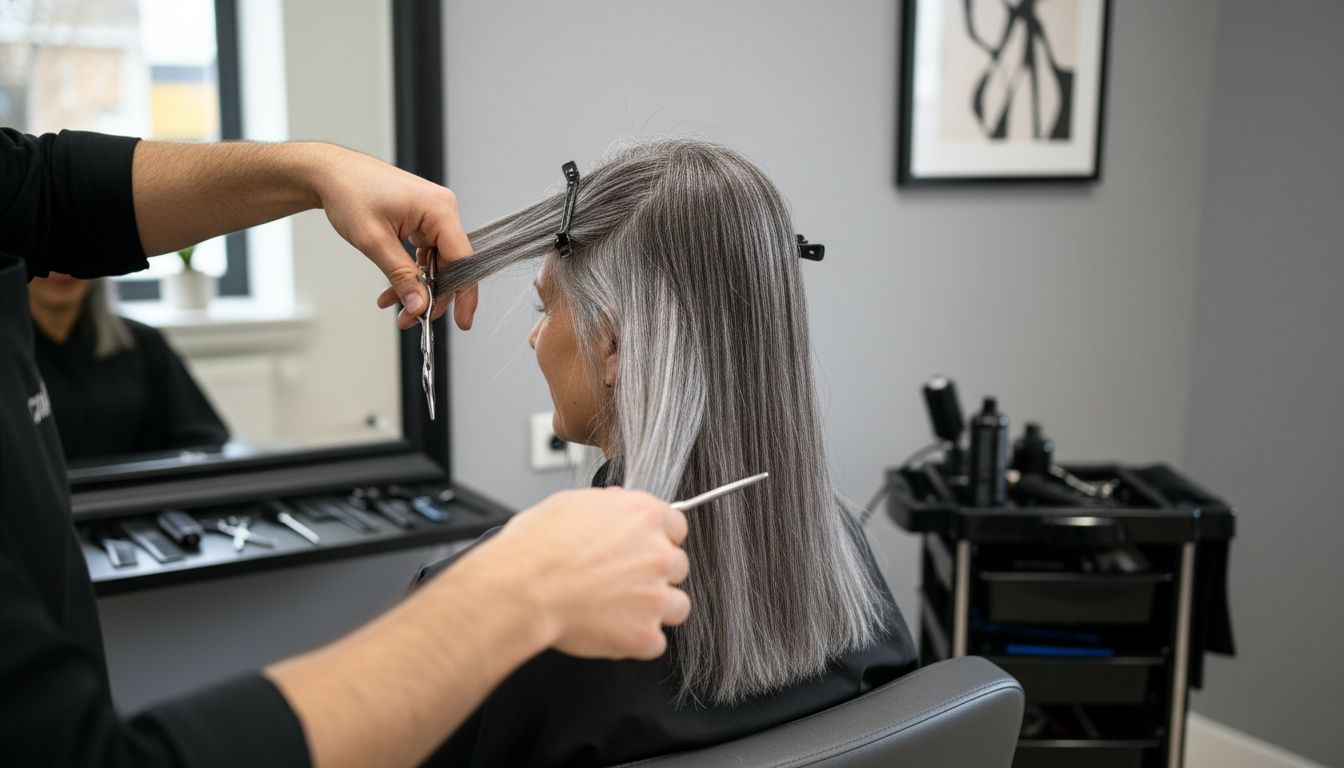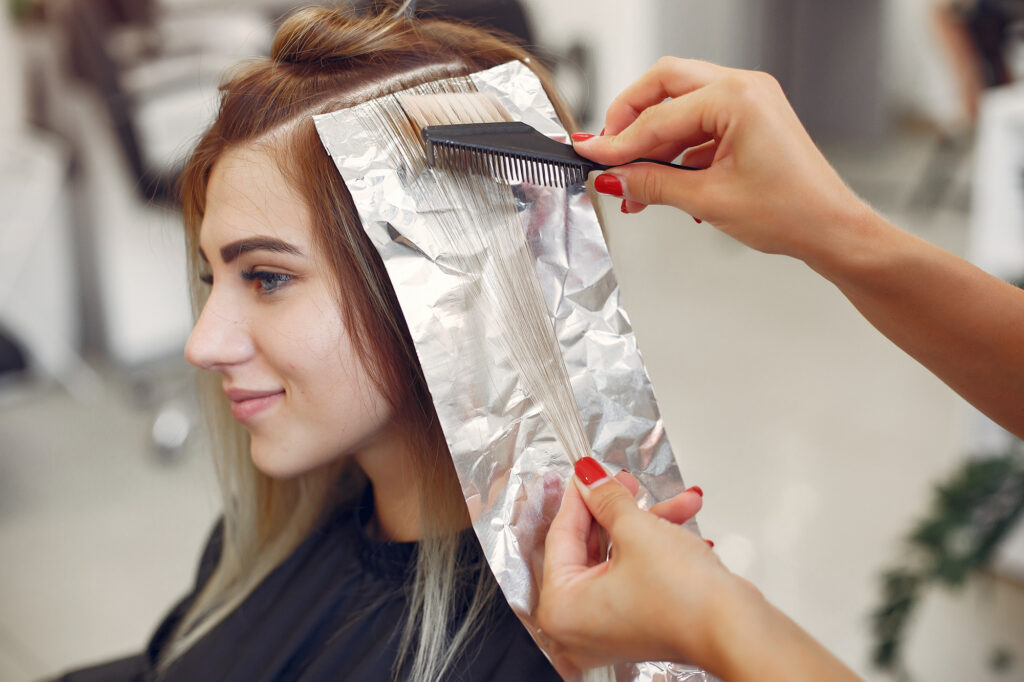Transitioning to Gray Hair: Complete Expert Guide

Over 70 percent of people will notice their first gray hair before age 50, yet the real story behind this shift goes far beyond simply getting older. The science shows that the transition to gray hair is shaped by your unique mix of genetics, stress, and biology. Understanding how and why this transformation happens can help you approach your own journey with more confidence, whether you want to embrace or manage those new silver strands.
Table of Contents
- Defining The Transition To Gray Hair
- Methods For Embracing Natural Gray
- Stages And Timeline Of The Process
- Expert Techniques And Salon Approaches
- Caring For Gray Hair And Maintenance
- Common Pitfalls And How To Avoid Them
Key Takeaways
| Point | Details |
|---|---|
| Understanding Graying | Hair graying is a complex biological process influenced by genetic, environmental, and cellular factors, rather than just age. |
| Embracing the Transition | Transitioning to gray hair requires a personal approach that combines self-acceptance and informed decision-making regarding hair care. |
| Professional Guidance | Expert stylists can provide tailored strategies for managing gray hair, utilizing advanced techniques and personalized consultations. |
| Targeted Maintenance | Gray hair care necessitates specific hydration and protection strategies to address its unique texture and needs, ensuring healthy and vibrant silver strands. |
Defining the Transition to Gray Hair
Hair graying is a natural biological process that transforms your hair color from its original pigmented state to silver, white, or gray tones. Unlike popular misconceptions, this transition is far more complex than simply aging.
According to groundbreaking research from PubMed, the process of graying involves intricate interactions between genetic, environmental, and cellular factors. The scientific review reveals that hair pigmentation is not a straightforward linear progression but a nuanced biological mechanism influenced by multiple variables.
Key Factors Influencing Gray Hair Transition
- Genetic Predisposition: Your DNA plays a significant role in determining when and how quickly you’ll transition to gray
- Oxidative Stress: Cellular damage from free radicals can accelerate pigment loss
- Hormonal Changes: Shifts in hormonal balance can trigger melanin production disruption
Recent studies from PubMed highlight that biological mechanisms underlying hair graying are more sophisticated than previously understood. Researchers now recognize this transition as a complex interplay of genetic inheritance, environmental exposure, and individual physiological processes.
The journey to gray hair is deeply personal. While some individuals embrace their silver strands as a symbol of wisdom and experience, others view it as a transformative aesthetic choice. Understanding the science behind this natural transition empowers you to make informed decisions about your personal style and hair care approach.
Methods for Embracing Natural Gray
Embracing your natural gray hair is a transformative journey that goes beyond simple color maintenance. It represents a personal choice of self-acceptance, style, and confidence that requires strategic planning and emotional preparation.
According to research from PubMed, understanding the psychosocial dynamics of hair color transition is crucial. The review highlights that embracing gray is not just a physical transformation but an emotional process involving self-perception and societal expectations.
Strategic Approaches to Gray Hair Transition
- Gradual Blending: Work with a professional stylist to create a seamless transition
- Strategic Cutting: Use strategic haircuts to minimize harsh color demarcations
- Deep Conditioning: Invest in specialized treatments that enhance gray hair’s natural texture
Recent scientific investigations from PubMed suggest that understanding melanogenesis regulation can provide insights into hair color transitions. This research indicates that embracing gray is not about surrender, but about understanding your hair’s natural biological processes.
The transition to gray is deeply personal. Some view it as revealing natural beauty, while others see it as a bold style statement. Professional stylists recommend patience, proper hair care, and a positive mindset as key elements in successfully navigating this aesthetic journey.

Stages and Timeline of the Process
Transitioning to natural gray hair is a nuanced journey that unfolds differently for each individual. Unlike a sudden switch, this process typically occurs gradually, with multiple distinct stages that can span several years.
Research from PubMed reveals that the hair graying progression is not uniform across all individuals. The comprehensive review highlights that genetic predisposition, lifestyle factors, and overall health significantly influence the timeline and intensity of gray hair development.
Typical Gray Hair Progression Stages
- Early Sporadic Stage: First few gray hairs appear, usually around temples or part lines
- Incremental Expansion Stage: Gray hairs increase, creating a salt-and-pepper appearance
- Dominant Gray Stage: Majority of hair transitions to silver or white tones
- Complete Transformation Stage: Full head of gray or white hair
According to PubMed, the biological variation in hair pigmentation loss means some individuals might experience rapid transformation while others see a more gradual transition. Factors like ethnicity, genetics, and overall health can accelerate or slow this natural process.
![]()
The timeline for complete gray hair transformation typically ranges from 5 to 15 years, though individual experiences vary widely. Embracing this journey requires patience, understanding, and a positive approach to personal aesthetic changes.
Expert Techniques and Salon Approaches
Professional hair transitions require specialized techniques that go beyond traditional color treatments. Expert stylists understand that managing gray hair is an art form that demands precision, creativity, and advanced technical skills.
According to research from PubMed, recent advancements in hair treatment strategies offer multiple innovative approaches for managing gray hair. The study highlights emerging techniques including topical melanin stimulants, targeted antioxidant treatments, and specialized low-level laser therapies that can enhance hair texture and appearance.
Key Professional Salon Strategies
- Customized Color Blending: Seamlessly integrate gray strands with existing hair color
- Precision Cutting: Use strategic haircuts to showcase natural gray patterns
- Specialized Conditioning: Apply professional-grade treatments that enhance gray hair’s unique texture
- Personalized Consultation: Develop individualized transition plans based on hair type and personal style
Research from PubMed suggests potential breakthroughs in hair repigmentation techniques, indicating that salon approaches are continuously evolving. When seeking professional guidance, look for stylists who combine scientific understanding with artistic vision.
Choosing the right salon is crucial in your gray hair journey. Luxury hair salons understand that each client’s transition is unique, requiring personalized strategies that celebrate individual beauty and style.
Caring for Gray Hair and Maintenance
Gray hair maintenance requires a specialized approach that differs significantly from traditional hair care routines. Unlike pigmented hair, silver strands have unique texture, porosity, and vulnerability that demand targeted, sophisticated care strategies.
Research from PubMed reveals groundbreaking insights into advanced hair maintenance techniques. The study highlights innovative approaches including targeted antioxidant treatments, specialized dietary supplements, and low-level laser therapies designed to enhance gray hair’s health and appearance.
Essential Gray Hair Care Strategies
- Hydration-Focused Products: Use moisture-rich, sulfate-free shampoos
- Purple Toning Treatments: Neutralize unwanted yellow or brassy tones
- Protein-Based Conditioning: Strengthen hair’s structural integrity
- UV Protection: Shield delicate gray strands from environmental damage
According to PubMed, understanding the biological mechanisms of hair aging is crucial for effective maintenance. The comprehensive review emphasizes that proactive care can significantly impact gray hair’s health and appearance.
While maintaining gray hair requires dedication, the right approach can transform your silver strands into a stunning, luminous asset. What defines a high-end salon experience is their ability to provide personalized, scientifically-informed care that celebrates your unique hair journey.
Common Pitfalls and How to Avoid Them
Transitioning to gray hair is a complex journey fraught with potential missteps that can derail your aesthetic goals. Understanding these common pitfalls is crucial for maintaining healthy, beautiful silver strands that reflect your personal style and confidence.
Research from PubMed highlights the significant psychosocial challenges associated with hair color transition. The review emphasizes that many individuals encounter emotional and practical obstacles during their gray hair journey that require strategic navigation.
Critical Pitfalls to Recognize
- Rushed Transition: Attempting to change hair color too quickly without professional guidance
- Improper Product Selection: Using hair care products not specifically designed for gray hair
- Neglecting Moisture Balance: Failing to address the unique hydration needs of gray strands
- Ignoring Scalp Health: Overlooking the importance of specialized scalp care during color transition
According to PubMed, biological factors significantly influence hair graying progression. Understanding these underlying mechanisms can help you develop more effective prevention and maintenance strategies.
What defines a high-end salon experience is their ability to provide personalized guidance that helps clients avoid these common pitfalls, transforming potential challenges into opportunities for personal expression and style evolution.
Embrace Your Gray Hair Journey with Expert Care at Joel C Ma Hair Studio
Transitioning to gray hair is a personal transformation influenced by complex biological factors like oxidative stress and melanogenesis regulation. The challenge lies in managing your hair’s unique texture and appearance while avoiding common pitfalls such as rushed transitions and improper product choices. If you want to celebrate your natural beauty with confidence and expert guidance, it is essential to partner with stylists who understand both the science and artistry behind gray hair.

At Joel C Ma Hair Studio, our team of expert hair artists offers personalized consultations and advanced techniques tailored specifically for your gray hair journey. We focus on gradual blending, precision cutting, and specialized conditioning treatments that honor your hair’s natural changes. Experience the luxury of a salon that combines 25 years of artistic expertise with carefully crafted care to reveal your most radiant silver strands. Visit us now to start a transformation that embraces your authentic self with sophistication and style.
Frequently Asked Questions
What causes hair to turn gray?
Hair graying is a natural process influenced by genetic predisposition, oxidative stress, and hormonal changes that disrupt melanin production in hair follicles.
How can I effectively embrace my natural gray hair?
To embrace gray hair, consider gradual blending techniques with a stylist, special haircuts to minimize color demarcations, and deep conditioning treatments to enhance texture.
What are the stages of transitioning to gray hair?
The transition to gray hair typically includes four stages: early sporadic graying, incremental expansion, dominant gray, and complete transformation to gray or white hair.
What are the best care strategies for maintaining gray hair?
Maintain gray hair by using hydration-focused products, purple toning treatments to neutralize brassy tones, protein-based conditioning, and UV protection to shield your hair from environmental damage.
Recommended
- How to Transition from Highlights to Balayage Beautifully – Joel C Ma Hair Studio
- How to Choose a Hair Color for a Stylish Transformation – Joel C Ma Hair Studio
- How to Pick a New Hair Color for Stunning Results – Joel C Ma Hair Studio
- How to Pick Hair Color: Expert Steps for Stunning Results – Joel C Ma Hair Studio





